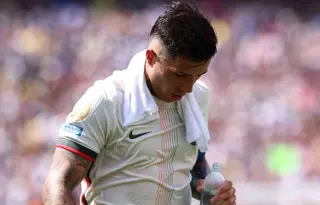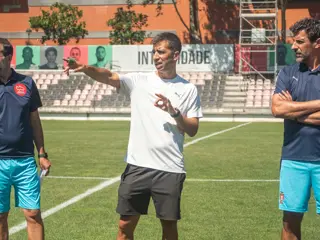News
FIFPRO, SJPF and PFF conduct scientific study to better understand how extreme heat affects players

- The study was conducted on 12 out-of-contract footballers taking part in the Portuguese union’s training camp
- Players were monitored during two 90-minute matches when ambient temperature exceeded 32C and Wet Bulb Globe Temperature (WBGT) exceeded 28C
- Extreme heat was a concerning theme at the FIFA Club World Cup; FIFPRO believes current guidelines do not do enough to protect the health and performance of players
FIFPRO, Portuguese player union SJPF, and the Portuguese Football Federation (FPF) conducted a scientific study to better understand how extreme heat affects players’ physical and physiological health.
The study, which was conducted on 12 out-of-contract footballers taking part in the union’s training camp in Odivelas, Portugal, analysed the effects intense heat has on the players’ core temperature and performance.
Players were monitored during two 90-minute matches when ambient temperature exceeded 32C and Wet Bulb Globe Temperature (WBGT) exceeded 28C. During these matches various mitigation strategies were implemented, such as cooling breaks every 15 minutes. Comparisons in distance covered, acceleration, deceleration, sprint, heart rate, dehydration levels and core temperature were also made.
"We know high temperatures influence players' performance and that it can affect their health negatively. In some cases, excessive heat can lead to heatstroke, so this is an area where FIFPRO logically remains proactive and progressive," explained Prof Dr Vincent Gouttebarge, FIFPRO’s Medical Director.
"We need to focus on developing optimal mitigation strategies so that players can perform safely; this is something that is very important for FIFPRO, the Portuguese union and Portuguese FA."
"With global warming, we will have more and more football matches played in hot conditions," said Joao Brito, Director of Performance and Research at the Portuguese Football Federation. "In this project, we are seeking to better understand the physical and physiological responses of players when they have to play in the heat, so that the best strategies for protecting athletes can be adopted, both in terms of training and the organisation of competitions."
Joaquim Evangelista, President of Portuguese player union SJPF, said: "The players’ union remains concerned about this issue. Football needs to adapt. After what happened at the last Club World Cup, it has never been more important to give space to scientific knowledge and find mitigation strategies that protect the health and wellbeing of our players."
What can be learned from the Club World Cup?
Extreme heat was a concerning theme at the FIFA Club World Cup, where players in the United States had to endure temperatures that hit 37C. Enzo Fernandez, who went on to win the tournament with Chelsea, said: "Honestly, the heat is incredible. I had to lie down on the ground because I was really dizzy. Playing in this temperature is very dangerous."
FIFA guidelines currently rely on the Wet Bulb Globe Temperature (WBGT), a measure of heat stress combining temperature and humidity. FIFA’s standard threshold for cooling breaks is 32C.

FIFPRO believes current guidelines do not do enough to protect the health and performance of players and recommend breaks should be introduced once the WBGT goes above 26C, and that matches should be delayed if the WBGT temperatures exceed 28C.
It means FIFPRO believes a number of games during the Club World Cup should have been postponed due to temperatures exceeding their maximum recommended threshold. It raises questions about player welfare when looking towards next year’s FIFA World Cup, to be held during the same months as the Club World Cup, in the United States, Canada and Mexico.
According to Prof Dr Gouttebarge, the added value of an extended half-time break to keep players’ core temperatures within acceptable range needs to be explored.
"A half-time of 15 minutes might not be enough to decrease the core temperature. Research is being done into alternative mitigation strategies and it could be that a half-time of 20 minutes has significant added value.
"That is why the results of this collaboration with the Portuguese player union and Portuguese Football Federation will be crucial."



